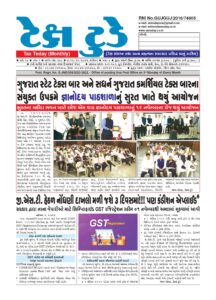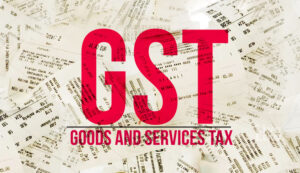GST WEEKLY UPDATE :20/2025-26 Dt. 17.08.2025 by CA Vipul Khandhar

-By CA Vipul Khandhar
- AATO Aggregate Annual Turnover (AATO) information maintained on the NIC e-Invoice Portals (einvoicel.gst.gov.in and einvoice2.gst.gov.in) is being aligned with the turnover data computed in the GST system: Advisory
This is to inform you that the Aggregate Annual Turnover (AATO) information maintained on the NIC e-Invoice Portals (einvoicel.gst.gov.in and einvoice2.gst.gov.in) is being aligned with the turnover data computed in the GST system. Accordingly, the AATO as per GST system records would be reflected on the NIC e-Invoice portals with effect from 1st September 2025. In case you notice any discrepancies in your AATO as displayed on the IRP portal after the said date, you may raise the matter by logging a ticket on the GST Grievance Redressal Portal or contacting the GST Helpdesk. Thank you for your cooperation.
- Enhancement of Interoperable Services between E-Way Bill1 and E-way Bill -2 –Portals:
As you are aware, NIC implemented the Interoperable services for the E-Way Bill -1-and E- Way Bill 2 portals in September 2024.
In the initial release, only the following criss-cross operations were enabled:
Updating of PartB
- Get EWB
That is, E-Way Bills generated on E-Way Bill 1 (with atleast one Part Ben try made on E- Way Bill 1) were allowed to update Part B from E-Way Bill 2. Similarly, E-Way Bills generated on E-Way Bill 2 were accessible from the same portal for such operations.
Enhanced Criss-Cross Operations–August2025
We are pleased to inform you that the following additional criss-cross operations have now been enabled:
1. Updating of Part B for Part A Slips (First-Time Update):
It is now possible to update Part-B for Part –A slips across portals, even for the first time.
Examples:
- For a Part A slip generated at E-Way Bill1, Part B can be updated at E-Way Bill 2.
- For a Part A slip generated at E-Way Bill-2, Part B can be updated at E-Way Bill 1.
2. Extension of E-Way Bill:
You can now extend the validity of an E-Way Bill generated at one portal using the other portal.
- E-Way Bill generated at E-Way Bill1 can be extended at E-Way Bill-2.
- E-Way Bill generated at E-Way Bill-2 can be extended at E-Way Bill1.
3. Updating of Transporter:
It is now possible to update transporter details across portals.
Transporter can be updated for E-Way Bills generated at E-Way Bill-1from E-Way Bill 2, and vice versa.
In the earlier release the following criss-cross operations were enabled
| E Way Bills Generated at | Part B Updation of Part A slip | Part-B Updation of E Way Bill | Extension | Transporter Update |
| EWB1 | ✓ | ✓ | ✓ | ✓ |
| EWB2 | ✗ | ✓ | ✗ | ✗ |
| EWB 1 Criss CrossatEWB2 | ✗ | ✓ | ✗ | ✗ |
| EWB 2 Criss CrossatEWB1 | ✗ | ✗ | ✗ | ✗ |
New release the following Enhanced Criss-Cross Operations.
| E Way Bills Generated at | Part-B Updation of Part A slip | Part-B Updation of E Way Bill | Extension | Transporter Update |
| EWB1 | ✓ | ✓ | ✓ | ✓ |
| EWB2 | ✓ | ✓ | ✓ | ✓ |
| EWB1CrissCross at EWB 2 | ✓ | ✓ | ✓ | ✓ |
| EWB2CrissCross at EWB 1 | ✓ | ✓ | ✓ | ✓ |
Note:
- Interoperable Services between the E-Way Bill1 and E-Way Bill-2 portals are intended primarily for emergency or fall back use only.
In case the E-WayBill-1 portal becomes temporarily unavailable, users may switch to the E-Way Bill 2 portal to continue generating and managing E-Way Bills without disrupting their business operations.
- When using Interoperable Services between the two portals, updates may take some time to reflect in functions such as Print/Get Details.
Therefore, during cross-portal operations, please wait for atleast-2-minutes for the data to sync between the portals before performing any subsequent actions.
- The GST portal has introduced “Navigate to GSTR-1A”: new function:
The Goods and Services Tax Network (GSTN) has rolled out a new feature, “Navigate to GSTR-1A”, on the GST Portal. This option appears on the payment page of GSTR-3B, allowing taxpayers to directly move to the GSTR-1A dashboard.
As per GSTN, the “Navigate to GSTR-1A” button will be enabled only if the taxpayer has not yet filed their GSTR-1A or GSTR-3B. On clicking the button, users will be redirected to the GSTR-1A section, making it easier to review and make necessary amendments to outward supply details before final filing.
- ITC verification of the new registered tax payer: The Rajasthan Commercial Taxes Department issued Circular No. F.17 (134) ACCT/GST/2017/547 dated August 12, 2025regarding verification of Input Tax Credit claims for new registrations, registered after the prescribed time limit under CGST/RGST Act, 2017.
On perusal of Section 25 of the RGST Act provides for procedure for registration. Sub-section of (1) of Section 25, Further, Section 18 of the RGST Act, 2017 provides for availability of credit in special circumstances with certain conditions and restrictions as prescribed by the Government. Clause (a) of Sub-Section (1) of Section 18 of the said Act, The claim of such ITC has been laid down in rule 40 of the Rajasthan Goods and Services Tax Rules, 2017.
A perusal of the aforesaid legal provisions makes it evident that the benefit of ITC pertaining to the transactions made prior to the date of registration is available only to the persons applying for registration within 30 days of being liable for registration. However, it has been observed that many a times, applications for registration are filed beyond the required period of thirty days. GSTN/CRU has informed that currently, the system applies check of thirty days for filing of ITC-01 from the date of grant of registration. A Para has been raised by Comptroller and Auditor General of India (CAG) in chapter 2 of his Report (Revenue) Year 2018-19, regarding new registration after the prescribed time limit under Goods and Service Tax Act, 2017. Further, it has been objected and asked that in cases where the taxpayers have applied for registration after thirty days from the date on which they were liable for registration, what procedure is adopted to check the veracity of claims of Input Tax Credit (ITC), if any, on pre-registration stock.
Therefore, it is directed that all proper officers shall ensure regular monitoring of all new registrations and in cases, where the taxpayers have applied for registration after thirty days from the date on which they liable to be registered, the concerned officers shall proceed to reject all claims of ITC pertaining to the period prior to the date of application of registration.
- AAR & Important Judgements:
(i) The Goods and Services Tax Appellate Tribunal (GSTAT) Principal Bench, New Delhi, has delivered its first-ever Final Order No. NAPA/31/PB/2025 dated August 07, 2025, in an anti-profiteering matter, upholding a finding that M/s Urban Essence (Subway franchisee) profited ₹5,47,005 by not passing on the GST rate reduction benefit on restaurant services from 18% to 5% (effective 15.11.2017) to consumers.
The Director General of Anti-Profiteering (DGAP) initiated proceedings based on a complaint regarding one product, but expanded the probe to all 340 products sold by the respondent, citing Section 171(2) of the CGST Act and Rule 129(2) of the CGST Rules. The Tribunal affirmed this wider scope, ruling that investigations are not confined to the specific item in a complaint.
Key findings:
- GST Rate Reduction Benefit Denied – The respondent increased base prices immediately after the rate cut, neutralising the tax benefit to customers.
- Burden of Proof Not Discharged – The respondent failed to provide any cogent evidence that the price hikes were due to genuine cost increases.
- ITC Claim Rejected – No invoices/debit notes were produced to support claims under CBIC Press Release No. 62/2018.
- Legal Principle – GSTAT reiterated that Section 171’s presumption of price reduction is rebuttable but must be countered with clear, verifiable evidence.
Order:
The respondent must deposit ₹5,47,005 plus 18% interest (from 15.11.2017) into the Consumer Welfare Funds of the Centre and Maharashtra within 3 months, failing which recovery will follow. No penalty was imposed as the violation period preceded the introduction of Section 171(3A) penalties (from 01.01.2020).
(ii) Hon’ble Supreme Court Decision Regarding Prohibition u/s 6(2)(b) inapplicable to parallel search and seizure proceedings:
(Applicant – Armour Security (India) Ltd)
“Initiation of proceedings” means formal adjudication via SCN, not summons, searches, or evidence-gathering. The “subject matter” refers to specific tax liability, deficiency, or obligation from a particular contravention. Identical or overlapping demands trigger the bar; distinct infractions do not.
(a) Are both actions addressing the same alleged offence or liability on identical facts? and (b) Is the relief/demand identical? If both answers are “yes,” Section 6(2)(b) applies.
Routine actions from audits or return scrutiny must be initiated by the authority (Central or State) the taxpayer is assigned to. However, intelligence-based enforcement (e.g., search, seizure) may be initiated by either authority, regardless of assignment.
If one authority has already started intelligence-based enforcement, the other should not initiate parallel proceedings on the same subject matter, even though non-adjudicatory investigative steps by different authorities are permissible.
- Compliance with Summons: An assessee must comply with summons, as their mere issuance does not indicate initiation of proceedings.
- Assessee’s Obligation to Inform: If an assessee is aware of an overlap in inquiry/investigation by different authorities, they must forthwith inform the authority that initiated the subsequent action in writing.
- Inter-Authority Communication: Upon receiving such intimation, tax authorities shall communicate with each other to verify the claim and avoid duplication.
- Intimation of Distinct Subject Matters: If the overlap claim is untenable, an intimation with reasons and distinct subject matters shall be conveyed to the taxpayer.
- Quashing Overlapping SCNs: Any show cause notice for a liability already covered by an existing SCN shall be quashed.
- Decision on Continuing Inquiry: If authorities find an overlap, they shall decide inter-se which authority will continue the inquiry/investigation, with the other forwarding all relevant material. The taxpayer cannot choose which authority proceeds.
- First to Initiate Rule: If authorities cannot agree, the authority that first initiated the inquiry/investigation shall continue, and courts may transfer the matter to that authority.
- Writ Petition as Recourse: If guidelines are not complied with, the taxpayer may file a writ petition under Article 226 of the Constitution.
Taxpayer Cooperation: Taxable persons must ensure complete cooperation with authorities.
Disclaimer:
This publication contains information for general guidance only. It is not intended to address the circumstances of any particular individual or entity. Although the best of endeavour has been made to provide the provisions in a simpler and accurate form, there is no substitute to detailed research with regard to the specific situation of a particular individual or entity. We do not accept any responsibility for loss incurred by any person for acting or refraining to act as a result of any matter in this publication.
(Author is a well known Chartered Accountant practicing in Direct and Indirect Taxes at Ahmedabad)





